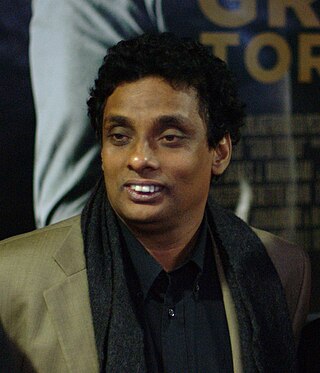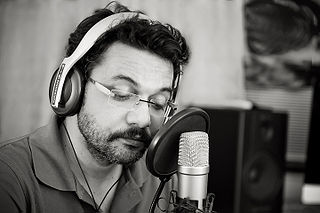
Bhubaneswar is the capital and the largest city of the Indian state of Odisha. It is located in the Khordha district. The suburban region, especially the old town, was historically often depicted as Chakra Khetra and Ekamra Khetra. Bhubaneswar is dubbed the "Temple City", a nickname earned because of many temples which are standing there. In contemporary times, the city is a hub of sports, tourism and IT in the country.

The Odia (ଓଡ଼ିଆ), formerly spelled Oriya, are an Indo-Aryan ethno-linguistic group native to the Indian state of Odisha who speak the Odia language. They constitute a majority in the eastern coastal state, with significant minority populations existing in the neighboring states of Andhra Pradesh, Chhattisgarh, Jharkhand and West Bengal.

Bijaya Jena, also known as Dolly Jena or Bijoya Jena, is an Indian actor, film director and producer. She won the Indian National Film Award for the Odia language film Tara.

Udaya Prasanna Vithanage is widely regarded as one of the most talented and influential filmmakers in South Asia. He is known for thought-provoking films that often deals with social, political and cultural issues. His films have received numerous awards accolades, both locally and internationally and have been praised for their innovative storytelling.

Odia cinema, also known as Ollywood, is the segment of Indian cinema, dedicated to the production of motion pictures in the Odia language widely spoken in the state of Odisha. Odia Cinema is based in Cuttack in Odisha, India. The name Ollywood is a portmanteau of the words Odia and Hollywood.

Neelesh Misra is an Indian journalist, author, radio storyteller, scriptwriter and lyricist. He hosted Yaadon Ka IdiotBox on BIG FM 92.7. He is co-founder and editor of Gaon Connection, a rural newspaper. He is working on "The Neelesh Misra Show" on Red FM 93.5 and "Kahaani Express" on Saavn.
Susant Misra is an Oriya film director whose films have been screened and feted at many international film festivals.
Teenkahon is a 2014 Psychological mystery-thriller Bengali film directed by Bauddhayan Mukherji and produced by Monalisa Mukherji under the banner of Little Lamb Films.

Titli (transl. Butterfly) is a 2014 Indian neo-noir crime drama film written and directed by Kanu Behl, and co-produced by Dibakar Banerjee Productions and Aditya Chopra under the banner of Yash Raj Films. It features actors Shashank Arora as the title character, Shivani Raghuvanshi, Ranvir Shorey, Amit Sial and Lalit Behl in the lead roles.

Luchakali is an Odia drama and thriller film released on 30 March 2012. it features Babushaan, Shriya Jha, Samaresh Routray and Ajit Das in key roles with original music by Anbu Selvam. It is partially inspired by Hollywood thriller Sleeping with the Enemy.
Indradhanura Chhai is a 1993 Indian Oriya film directed by Susant Misra. This film reflects the traditional structures of social and family life of a small town in India are growing strongly affected by the progressive urbanization of the country. Three generations of women see their perception of human nature to evolve, as their personal relationships. In their loneliness, they face problems of tradition, culture, religion and manage gender relations. Gradual urbanization and its consequences affect the traditional, social and family structures in a growing small town in India. The story explores the multidimensional conflicts of three women of different generations, their changing perceptions about human nature and personal relationships. Their lonely moments are highlighted in the context of the inexorable flow of time amidst issues of tradition, culture, religion and man-woman relationships.

Biswanath Rath is an Indian film director, screenwriter, editor and producer. His films have received a total of 530 recognition/awards in various International Film Festivals across the globe. He is the Odia filmmaker to achieve the milestone of winning 500 film festival accolades which includes 118 awards. He is the founder of production company BnR Films LLP.

Amartya Bhattacharyya is a filmmaker, writer and artist from eastern India. He was awarded the Silver Lotus for the Best Cinematography in non-feature film at the 63rd National Film Awards by the president of India for his fantasy documentary 'Benaras-the unexplored attachments'. His second feature film 'Khyanikaa - The Lost Idea' featured as the only Odia film in the Indian Panorama section of 48th International Film Festival of India 2017. He was awarded the State film awards in Best Editing category for Khyanikaa - The Lost Idea at the 29th Odisha State Film Awards, conferred by the Government of Odisha.

Akshay Kumar Parija is an Indian film maker known for his depictions of Odia culture and Odissi dance in his films. Originally a banker, he currently lives in Dubai.
Tulasi Apa is a 2017 first Odia biographical film, produced by Anupam Patnaik and directed by Amiya Patnaik. The film depicts the life of Tulasi Munda, an educator and social activist from Keonjhar, Odisha. The film was released on 19 May 2017.

Khyanikaa: The Lost Idea is a 2017 Odia language independent feature film written and directed by Amartya Bhattacharyya. The film won the state award for Best Editing at the 29th Odisha State Film Awards which was awarded to the filmmaker Amartya Bhattacharyya, who was also the editor of the film.
Runanubandha - The HE without HIM is a 2018 Bengali language independent feature film written and directed by Amartya Bhattacharyya. The film premiered at the International competition section at the 24h Kolkata International Film Festival.
Barsha Patnaik is an Indian actress, born in Paradip, Odisha. She works in Odia cinema industry. Her debut film was Tulasi Apa. Debut film earned her success as she was awarded Best actress in 27th Odisha State Film Awards presented by the Government of Odisha.

Adieu Godard is a 2021 Odia language independent drama film written and directed by Amartya Bhattacharyya. The film world premiered at the 43rd Moscow International Film Festival 2021. In India, the film got officially selected at festivals like IFFK (Kerala), KIFF (Kolkata), Bengaluru (BIFFES), Pune (PIFF) etc. Adieu Godard also won Best Film Award in the Indian Languages competition at the 27th Kolkata International Film Festival 2022 and the 'Third Best Indian Cinema Award' at the 13th Bengaluru International Film Festival 2022.

Dipanwit Dashmohapatra is an Indian actor and theater artist who predominantly works in Odia movies and web series.















